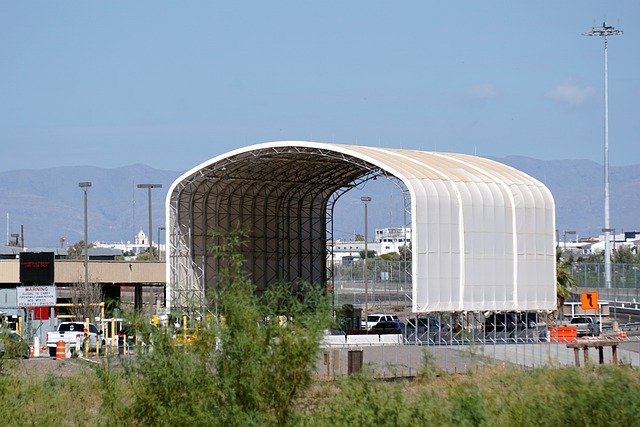Presidio has only 5,000 residents. It is the smallest in Texas, located in the middle of the desert, 100 km from the nearest city, with a border crossing to Mexico.


The border in Presidio runs through the middle of a bridge connecting both banks of the Rio Grande River. It is a concrete structure with a safety fence along the sides of the road to prevent anyone from thinking of jumping or climbing on the bridge. There is a one-lane road in both directions. The river, since 1949, has been dry in the section from El Paso to Ojinaga. The riverbed under the bridge is completely dry. However, not far from here, in Presidio, the Rio Grande is fed by another Mexican river, the Rio Conchos. The water once again fills the bed of the famous river, flowing uninterrupted to the Mexican Gulf.


To this day, Border Patrol officers refer to working in Presidio as a “hardship station.” Despite the significant increase in border traffic, the border crossing has not changed since it opened in the 1980s. It is a job in harsh conditions, not only because of the weather but also due to the distance. The nearest hospital is an hour and a half drive away, in Alpine. In reality, it’s a hospital in name only and could more accurately be called a clinic. If something serious happens, planes or helicopters are called to take people either over four hundred kilometers west to El Paso or a similar distance to Odessa. Life in Presidio is life on the outskirts of civilization.


In the town, there is a DOLLAR deli, an auto parts store, and a few other small shops. There are more options in Mexico. The food there is better and cheaper. With the current exchange rate, you can buy much more on the other side. In Presidio, 75% of the population has Mexican roots, and most of them come from Ojinaga, just across the Rio Grande. On weekends, most people from Presidio go to Mexico because they have family there—parents, in-laws, grandparents, or siblings. In the past, crossing the border used to be quick and efficient. However, a few years ago, traffic jams began. The worst is on weekends. Sometimes, after vacations or holidays, when people leave for a long weekend, the traffic can be so bad that to get back into the U.S., you have to expect to wait up to seven hours.

Unfortunately, the border crossing on the bridge only has one lane in each direction. When it was built, no one predicted that border traffic would grow this much. After all, it’s in the middle of the desert. Despite the traffic jams, people still drive through. It’s a matter of Mexican mentality. Being able to visit and spend time with family is more important. Often, for example, a husband has a green card and returns to Mexico to be with his children and wife, who don’t have it yet. The father works in the U.S. all week and returns home for the weekend.
There aren’t many jobs in Presidio itself. The largest employers are the schools: elementary, middle, and high school, Big Bend National Park, and around 70 people are employed at the border crossing. Most people work outside of town, often in the oil industry or construction. West Texas and New Mexico are full of oil fields. Most people leave Presidio for a week or even a month or two, depending on how far the job is and what the contract looks like. Some people get contracts for three or four months, so they leave Presidio and return after their work ends. During the contract, they live in RVs or gather in groups to rent apartments or houses locally. After a few months, they return home. Until the next trip.
On the Mexican side, around Ojinaga, people mainly make a living working on ranches. It’s an important cattle breeding and collection hub. During the week, large shipments of trucks full of calves and cows pass through. In Presidio, representatives from companies wait to buy them from the Mexicans. Americans often also buy young cows and bulls from the Mexican side and bring them to the U.S. They take them to grazing lands or to breeding centers where they are fed, and then they are sent to slaughterhouses. Many people from Presidio work as truck drivers. There are also some small family businesses and shops. Even though most people work outside the town, and the town is small with about five thousand residents, it doesn’t empty out. People don’t want to leave. They appreciate the quiet, small-town atmosphere. Ojinaga has around 35,000 residents and it also doesn’t empty out. People are very connected to this place, especially family-wise. Most people of Mexican descent in this region are very traditional, and even in Presidio, on the American side, you can feel it everywhere. People go to Ojinaga not treating it as crossing a border. They go to Ojinaga to go to the store, to visit a bar. They live in both countries at the same time. Many people have a home in Presidio, where they live during the week because their children go to school there, and on the weekend, they go to Mexico because that’s where their entire family lives. There’s always a reason to go back to Mexico—whether it’s for a first communion, birthdays, christenings—there’s always a reason to meet and return to Mexico.


Ojinaga is unique because it’s a small town. A lot of people go not only to visit family but also, for example, to see a doctor, dentist, or to get medication from the pharmacy. In Texas, a dentist charges 1000 USD for a filling, while in Mexico, the same procedure costs 100 USD. The choice is simple.
Interestingly, in Presidio, there is not a single store selling alcohol or a bar. Beer and wine are sold in grocery stores. If someone wants to buy something stronger, they have to go to Mexico or hundreds of miles north to the nearest American town. In Mexico, stronger alcohol is sold in grocery stores. From Mexico, you can bring back 24 beers or four liters of vodka, tequila, or whiskey for personal use.
There are very few tourists at the border. If they come, it’s either early spring or autumn. Due to the temperatures, few people choose to visit in the summer.
